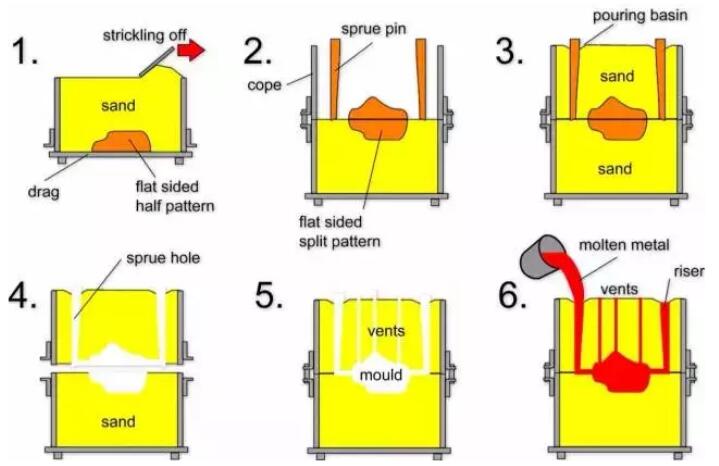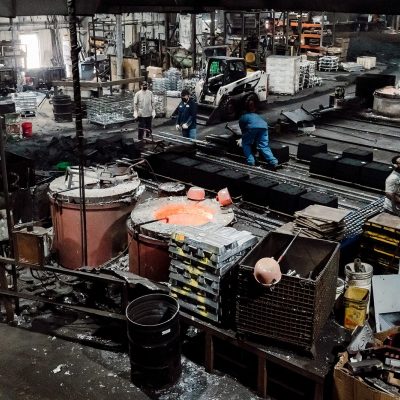How Aluminum Castings contribute to durable industrial components
Wiki Article
The Duty of Metal Casting ahead of time Production Technologies
Metal Casting have notably affected the evolution of making innovations. They use special layout flexibility, enabling the production of complex geometries necessary for various applications. Modern spreading strategies are being improved by innovations like 3D printing and automation. These growths not only enhance efficiency however likewise address obstacles in precision and sustainability. As industries remain to develop, the function of Metal Casting stays vital fit their future. What lies in advance in this dynamic field?The Development of Metal Casting Methods
As the demand for precision and performance in manufacturing has expanded, the advancement of Metal Casting strategies has actually undergone significant transformation. Historically, Metal Casting began with easy methods such as sand spreading and lost-wax casting, which allowed artisans to produce detailed shapes. In time, advancements in innovation introduced procedures like die spreading and financial investment casting, enhancing precision and decreasing waste. Aluminum Castings. The intro of computer-aided layout (CAD) and simulation software transformed the drawing board, making it possible for manufacturers to expect potential problems and optimize styles before manufacturing. Additionally, the growth of brand-new products, such as innovative alloys and compounds, has actually expanded the scope of applications for Metal Casting. Automation and robotics have further refined spreading processes, enhancing consistency and efficiency. As a result, the Metal Casting industry has actually adjusted to fulfill the needs of modern production, concentrating on sustainability and technology to remain competitive in an ever-evolving marketplace
Applications of Metal Casting in Secret Industries
The advancements in Metal Casting methods have actually opened a broad selection of applications across numerous sectors. In the vehicle sector, Metal Casting are indispensable for creating engine blocks, transmission housings, and other necessary elements that require high toughness and resilience. The aerospace industry uses spreadings for detailed components like turbine blades and architectural components, guaranteeing lightweight yet durable services for airplane.
The building and construction industry uses Metal Casting for structural components such as beam of lights and fittings, adding to the stability of buildings and infrastructure. In the energy market, castings play a vital duty in producing elements for wind turbines and power generation devices, enhancing performance and integrity. Additionally, the medical field take advantage of accuracy castings used in medical tools and prosthetics, demonstrating the flexibility of Metal Casting across varied applications. This wide usage emphasizes the significance of Metal Casting in modern-day production practices.
Advantages of Metal Casting in Modern Production
Metal Casting provide countless benefits that considerably improve contemporary manufacturing processes. One crucial advantage is design versatility; Metal Casting enables the development of complicated forms and intricate geometries that are usually tough or impossible to accomplish with various other producing methods. This capacity enables producers to enhance product styles for performance and performance.In addition, Metal Casting can support a wide variety of materials, consisting of iron, steel, and aluminum, which can be tailored to meet details mechanical residential or commercial properties and deterioration resistance requirements.

Cost-effectiveness is an additional significant advantage; Metal Casting procedures click now can produce huge amounts of components with very little product waste, consequently reducing production prices.
In addition, the durability of cast metal parts adds to the durability of products, reducing the demand for regular replacements. Overall, the benefits of Metal Casting substantially contribute to performance, sustainability, and innovation within modern production environments.
Developments Driving the Future of Metal Casting
While traditional Metal Casting methods have offered the market well for years, recent technologies are poised to revolutionize the area. Advancements such as 3D printing you can try here innovation permit rapid prototyping and the production of complex geometries that were previously unattainable. These technologies not only enhance design flexibility however likewise minimize waste and shorten lead times. Furthermore, the combination of automation and robotics in casting processes is enhancing procedures, enhancing accuracy, and improving employee security. The growth of brand-new alloys and composite materials is making it possible for the creation of stronger, lighter castings customized for specific applications. Digital innovations, consisting of expert system and device discovering, are maximizing spreading parameters and predictive maintenance, driving improved quality control. Collectively, these technologies are pressing the boundaries of Metal Casting, promoting greater performance and sustainability in manufacturing, and positioning the market for future development and competition.Difficulties and Solutions in Metal Casting Processes
As innovations in Metal Casting innovation proceed to improve the industry, various challenges continue to be that manufacturers must address to completely utilize these innovations. One considerable problem is the irregularity in material properties, which can lead to irregular top quality and performance. This irregularity usually arises from variations in raw products and handling problems. Additionally, the rising expenses of energy and materials posture monetary restraints, pressing makers to seek much check out here more efficient procedures.To combat these difficulties, companies are significantly taking on automated systems and advanced simulation strategies to improve precision and uniformity. Carrying out quality control procedures throughout the manufacturing procedure likewise aids in identifying flaws early. Investing in research study for alternative materials might decrease prices and improve sustainability. By resolving these difficulties with ingenious remedies, the Metal Casting market can boost productivity and preserve competition in the advancing manufacturing landscape.
Often Asked Questions
What Products Are Typically Used in Steel Casting Processes?
Typical products made use of in Metal Casting processes consist of aluminum, bronze, magnesium, and iron. Each product possesses distinct homes that satisfy different applications, enhancing the convenience and performance of the final actors products in different industries.Just How Do Ecological Rules Influence Metal Casting Operations?
Ecological laws force Metal Casting operations to embrace cleaner modern technologies and techniques, typically boosting production prices. Conformity might result in ingenious procedures that decrease waste and discharges, ultimately advertising sustainability within the Metal Casting industry.What Are the Safety And Security Actions in Metal Casting Facilities?
Precaution in Metal Casting facilities consist of proper ventilation, personal safety equipment, routine security training, tools upkeep, and adherence to safety laws, guaranteeing a safe atmosphere for employees while reducing dangers associated with dangerous products and procedures.Just How Is High quality Controlled in the Steel Casting Process?
Quality assurance in Metal Casting includes rigorous assessments, including aesthetic assessments, dimensional checks, and product screening. Adherence to market standards and carrying out quality management systems ensures that spreadings meet given requirements throughout the production procedure.
What Is the Future Job Overview for Metal Casting Professionals?
The future job overview for Metal Casting specialists shows up promising, driven by innovations in innovation and boosting need across numerous industries (Metal Castings). Development in automation and sustainable practices will likely produce brand-new opportunities in this marketHistorically, Metal Casting began with basic approaches such as sand spreading and lost-wax spreading, which enabled craftsmens to produce complex shapes. Over time, advancements in modern technology presented procedures like die casting and financial investment spreading, improving precision and decreasing waste. In addition, the clinical field benefits from precision castings made use of in medical instruments and prosthetics, demonstrating the versatility of Metal Casting throughout varied applications. Metal Casting use various advantages that greatly improve modern production processes. Typical products made use of in Metal Casting processes consist of light weight aluminum, iron, bronze, and magnesium.
Report this wiki page